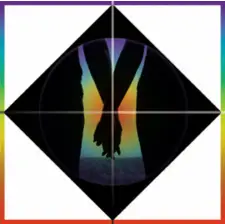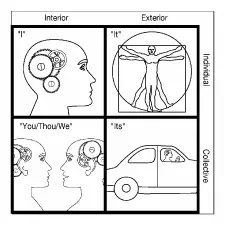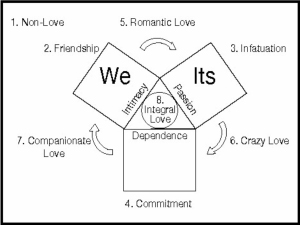|
TRANSLATE THIS ARTICLE
Integral World: Exploring Theories of Everything
An independent forum for a critical discussion of the integral philosophy of Ken Wilber
 Martin Ucik Martin Ucik is a German born entrepreneur who trained with Eckhart Tolle as a Power Of Now group facilitator and founded single2couples.org, an Association for Healthy Relationships. His studies of Ken Wilber's Integral Model enabled him to integrate his personal experiences as a divorced father and the wisdom from over 200 relationship books into Integral Relationships: A Manual for Men which Ken Wilber calls "a terrific book!" He lives in Santa Rosa, CA. Reposted with permission of the author from Martin's Integral Life blog.
Integral
Relationship
Dynamics
Martin Ucik

Looking at the state of our romantic love relationships through an Integral lens allows us to understand why almost half of the adult US population lives alone today. It also explains why many couples struggle in their relationships, why two thirds of divorces/breakups are initiated by women who would rather stay single than live with relationship morons, why many singles can't find a new partner, and—the good news—what level of development and relationship vision is required that allows men and women[1] in committed "Integral" relationships/marriages to co-create a sustainable and peaceful future for all humanity.
Let's start this series of blogs with a broad overview of the Integral Relationship model, which will allow us to put future conversations into this larger context.
We begin our exploration by differentiating between biological sex, learned social gender roles, and feminine/masculine polarities of males and females. This allows us to understand her primary sexual fantasy of attracting a successful male protector and provider with status and wealth, his primary sexual fantasy of attracting a physically attractive and healthy woman who supports him in (or shares) his purpose, her primary emotional reaction to relationship conflict with fear, and his with shame. This differentiation also provides pointers to a couples social expectations and compatibilities, and how they can balance and harmonize the opposing feminine and masculine polarities of agency, communion, ascending (Eros), and descending (Agape) in their healthy form to generate sexual attraction and synergy.
Next, the Integral Relationship model considers multiple intelligences, competencies, values, interests, passions, and emotional needs (developmental lines) that must be compatible between couples to generate a deep heart and soul connection, and for their relationships to thrive.
Especially crucial to an Integral understanding of relationship dynamics between men and women are their individual levels of development in four lines:
- Consciousness (eight levels from archaic to transpersonal)
- Spirituality (five levels from gross to non-dual),
- Sexuality (five levels from repressed to transcendent),
- His anima complex (five levels from women as mother to equal partner) and her animus complex (five levels from men as alien outsiders to equal partner).
The understanding of each partner's level of development in these four lines is paramount for their ability to meet each other as opposites and equals.
We further need to be aware of several states/phases that romantic relationships typically pass through (lust, infatuation, romance, conflict, uncertainty, negotiation, commitment and re-commitment). Knowing those allow us to stay cool when the various love hormones that impair our ability to make rational partner choices rush in and make working through difficult times even more difficult. We also consider personality types that help us to understand behavioral patterns, as well as our primary and secondary ways through which we give and receive love—either through words, time, gifts, service, or touch.

Once we are aware of these building blocks of the Integral Relationship model, we can integrate them by using Ken Wilber's insight that each human has (1) an interior mind and (2) exterior body, and is (3) simultaneously whole as an individual and (4) part of larger collectives. These four dimensions can be diagramed as four quadrants with the individual "I" in the upper left, the individual "It" in the upper right, and their collective extension/connection in the respective lower quadrants.
Realizing that relationships are always formed through the lower collective quadrants allows us to identify eight forms of love (non-love, friendship, infatuation, commitment, romantic love, crazy love, companionate love, and Integral love) that lovers may feel and co-create in kind and degree when a resonance in their (LL) collective interior (which generates intimacy), (LR) collective exterior (which generates passion) and/or unconscious dimension (which generates various forms of dependence, from co-dependence to inter-Being) is experienced.

Since the map is never the actual territory—which we should especially keep in mind when it comes to romantic love—the Integral Relationship model suggests considerate and compassionate observations, dialogs and experiences to determine the level of consciousness, spiritual, sexual, and anima/animus complex development of each partner when engaging in this most intimate and vulnerable form of human connections. Combining these insights and experiences with the number of perspectives (1st, 2nd, 3rd, 4th person etc.) that each partner can take allows us to define their individual Kosmic Address, which provides pointers to the type, quality, and sustainability of the love relationship that is most likely to develop. The lovers can then decide to improve an existing love relationship (if both partners are willing and capable to do so) or to end it with compassion and to develop an integral approach to finding/attracting a more compatible partner.
Note
[1] This statement is in no way intended to discriminate against gays and lesbians. Their world is just not familiar to the author. Most principles that are outlined in this blog may apply to their relationships as well.
|
 Martin Ucik is a German born entrepreneur who trained with Eckhart Tolle as a Power Of Now group facilitator and founded single2couples.org, an Association for Healthy Relationships. His studies of Ken Wilber's Integral Model enabled him to integrate his personal experiences as a divorced father and the wisdom from over 200 relationship books into Integral Relationships: A Manual for Men which Ken Wilber calls "a terrific book!" He lives in Santa Rosa, CA. Reposted with permission of the author from Martin's Integral Life blog.
Martin Ucik is a German born entrepreneur who trained with Eckhart Tolle as a Power Of Now group facilitator and founded single2couples.org, an Association for Healthy Relationships. His studies of Ken Wilber's Integral Model enabled him to integrate his personal experiences as a divorced father and the wisdom from over 200 relationship books into Integral Relationships: A Manual for Men which Ken Wilber calls "a terrific book!" He lives in Santa Rosa, CA. Reposted with permission of the author from Martin's Integral Life blog.


